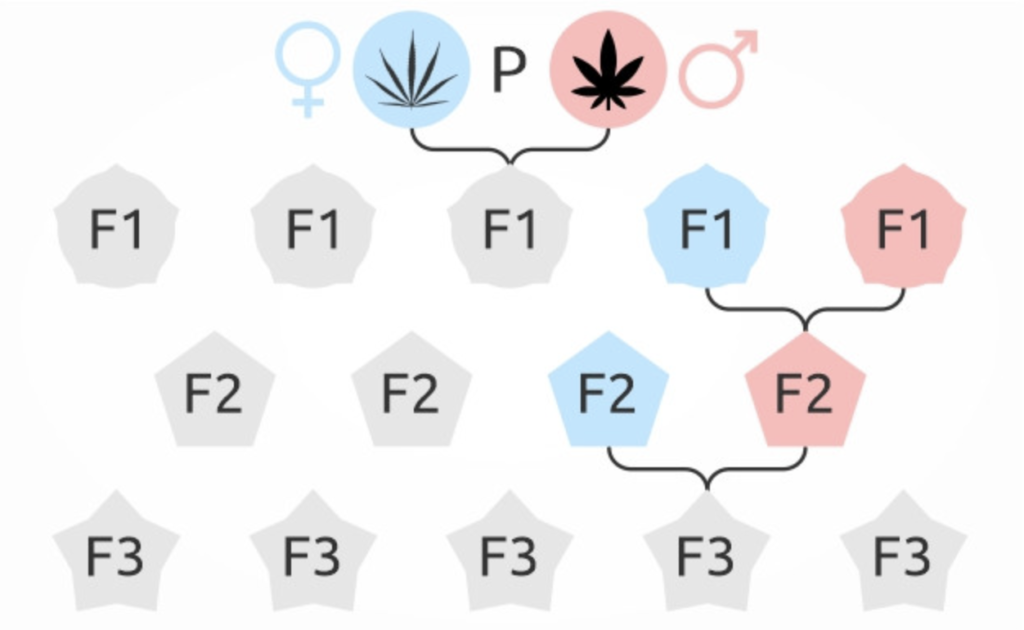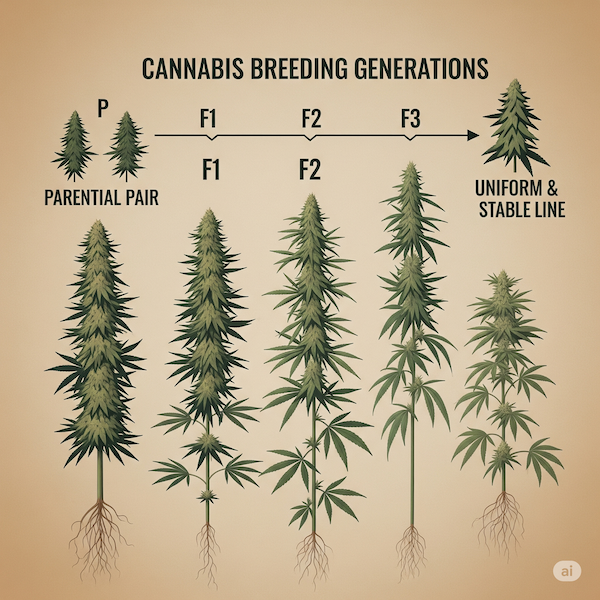G’day, legends! Matty here, and let’s be honest, sometimes the world of cannabis breeding can feel like a secret society with its own language, right? You’re scrolling through seed banks, eyeing up some beauties, and then you see terms like “F1 Hybrid,” “F2,” or “IBL”, and suddenly you’re scratching your head harder than a dog with fleas. What the bloody hell do they mean, and more importantly, what does it mean for your grow?
Well, settle in, grab a cuppa (or whatever wets your whistle), because today we’re going to demystify these F-numbers in cannabis seed generations. Understanding them isn’t just for the mad scientists in white coats; it’s crucial for getting the consistent, killer results you’re after in your own backyard (or grow tent!). Trust me, once you get your head around this, choosing your next strain will be a whole lot easier – and you’ll sound like a proper guru at your next barbecue.

🌳 The Family Tree of Your Green Mates: What “F” Actually Stands For
First off, let’s cut through the jargon. That “F” you see? It stands for Filial, which is just a fancy way of saying “of a son or daughter” or “related to offspring.” Basically, it tells you which generation of plant you’re looking at, counting from the original cross. Think of it like a family tree, but for plants!
Before we get to the F’s, let’s quickly meet the starting points:
- P (Parental Generation): These are the OG mum and dad plants, the initial two strains a breeder decides to cross. They’re the foundation of the whole genetic lineage.
🧬 The Generations, Demystified by Matty
A. F1 (First Filial Generation): The Hybrid Powerhouse
What it is, mate: The F1 generation is the first batch of offspring you get when you cross two distinct (and usually stable or “pure”) parent strains together. Think of it like a carefully arranged marriage between two top-tier families.
Why they’re rippers: F1s are famous for something called Hybrid Vigor (or heterosis, if you want to get real fancy). Simply put, when you cross two different but strong genetic lines, their kids often turn out even better than either parent. They’re typically more robust, grow faster, yield heavier, and can even be tougher against pests and diseases. They also tend to be very uniform, meaning if you pop ten F1 seeds from the same batch, they’ll usually look and grow very similarly. It’s like having a whole footy team where every player’s a star and they all move in perfect sync.
What you’ll find on the market: A massive chunk of the high-quality feminized seeds you buy online – especially the big-name strains you know and love – are effectively F1 hybrids, even if they’re not explicitly plastered with “F1” on the label. Breeders create these for consistency and performance, giving you a reliable product every time.
The New Breed (True F1 Autoflowers): Keep your eyes peeled for this exciting development! Some top-tier breeders are now pushing the boundaries with what they call true F1 hybrid autoflowers. These aren’t just any old F1s; they’re created by crossing two highly inbred and stable autoflower parent lines. The result? Unprecedented uniformity, explosive vigor, and sensational yields from your autos. These are the cutting edge, offering a level of predictability in autoflowers we’ve not seen before.

B. F2 (Second Filial Generation): The Genetic Lucky Dip
Now, if the F1 generation is like a perfectly synchronized footy team, the F2 generation is where things get a bit more… lively. This generation pops up when you cross two F1 individuals together (F1 x F1), or if you let an F1 plant self-pollinate.
The Genetic Wild West: This is where the real genetic lottery begins, mate! While F1s are pretty uniform, the F2 generation is where you see the most genetic variation and phenotypic diversity. Think of it like this: the F1s got a nice, even blend from their parents, but when they have kids (the F2s), all those hidden traits from the original grandparents suddenly decide to show their face in all sorts of surprising combinations. You might get tall ones, short ones, bushy ones, stinky ones, even some that look like they’ve had a bad hair day every day.
Pheno-Hunting Territory: For the keen-eyed grower or the aspiring breeder, F2s are gold. This is the generation where you pheno-hunt, meaning you grow out a bunch of them, looking for that one special plant with a unique combination of traits – maybe it’s got a crazy terpene profile, resistance to everything under the sun, or yields like a champion. It’s a bit like digging for treasure, and sometimes you find a real gem!
What you’ll find on the market: You’ll definitely see F2 seeds available, especially from smaller breeders or those specializing in “open source” genetics. They’re often priced a bit cheaper than stabilized F1s or IBLs because you’re essentially buying a lucky dip. If consistency is your main goal, F2s can be a bit of a headache. But if you love a bit of a genetic adventure, they can be a bloody good time.
C. F3, F4, F5+ (Subsequent Generations): The Road to Stability (and IBLs)
So, you’ve got your F2s, and they’re all over the shop, right? If a breeder wants to create a strain that reliably pumps out consistent plants every single time, they can’t stop at F2. That’s where the hard yards begin, and we start climbing the F-number ladder.
The Long Game of Selection: This is where breeders put on their mad scientist hats. They’ll grow out a pile of F2s, pick the absolute best ones that show the desired traits, and then cross those together to get the F3 generation. They repeat this process, climbing to F4, F5, and so on.
Marching Towards Uniformity: With each successive generation, the breeder is systematically locking in those desirable traits. Think of it like refining a secret family recipe over generations – removing dodgy ingredients and perfecting the flavours until it’s absolutely spot on. Over time, the genetic variation reduces and the plants become more uniform and predictable. They’re getting them all to march in line like a well-drilled army.
What’s an IBL, mate? When a strain reaches F4, F5, F6 or higher, it’s often considered an In-Bred Line (IBL). This means the genetics are highly stable and “true-breeding”. If you plant seeds from an IBL, you can confidently expect the offspring to look and perform very similarly. For commercial growers, or anyone who wants predictability, IBLs are gold!

🛒 Decoding What’s on the Seed Bank Shelf
So, you’ve got your head around F1, F2, and the long road to an IBL. But when you’re scrolling through those dazzling seed bank websites, the labels can still throw a spanner in the works. Here’s what Matty reckons:
- “Hybrid” (Unspecified F-number): Usually an F1. Risk: Low, Reward: Reliable results.
- “F1 Hybrid Autoflower”: Cutting-edge autos with great uniformity and hybrid vigor. Risk: Low, Reward: Consistency and speed.
- “F2”: Get ready for a genetic lucky dip! Risk: Medium, Reward: Potential for a keeper pheno.
- “IBL” or “F4/F5+”: Highly stabilized. Risk: Very low, Reward: Predictable results.
- “S1”: Selfed F1 seeds, generally consistent but might show slightly more variation.
🌿 Matty’s Top Tips for Navigating the Genetic Jungle
- Know Your Mission: If you need rock-solid predictability, stick to stable F1s or IBLs. If you’ve got space and time to pheno-hunt, F2s can be a fun ride.
- Do Your Homework on the Breeder: Read reviews, check forums, and make sure their gear is legit before handing over your cash.
- Don’t Be Shy, Ask Questions: If the genetics aren’t clear, reach out to the breeder or seed bank. Matty’s Mantra: “There’s no such thing as a stupid question in the grow room, only stupid mistakes you could’ve avoided by asking!”
- Embrace the Journey: Especially with F2s, enjoy the hunt. You might stumble on your next favourite keeper by accident!
🧑🌾 Real-Life Example: Matty’s (or a Mate’s) Genetic Gamble
You know, I’ve been in this game longer than some of you have been alive, and I’ve seen it all. But even an old dog like me, or more often, one of my mates, can get caught out by a bit of genetic misunderstanding. Let me tell you about ol’ Dazza…
Dazza was stoked, see. He’d found a pack of seeds online for a classic strain, dirt cheap. “Bloody bargain, Matty!” he reckoned, ringing me up. “They’re just F2s, but who cares, right? A seed’s a seed!” I mumbled something about “genetic variation,” but Dazza was already halfway to planting ’em.
Fast forward a few weeks, and Dazza calls me in a panic. “Matty, my grow room looks like a bloody circus! One plant’s a giant, another’s a dwarf, one smells like rotten fruit, and the one next to it smells like fresh lemons! And don’t even get me started on the yields – it’s all over the shop!”
I popped over, took one look at his chaotic jungle, and just grinned. “Ah, Dazza,” I said, pointing at the tag on his seed pack, “You didn’t just buy seeds, mate. You bought a ticket to the genetic lottery! Those F2s aren’t designed for uniformity; they’re designed for finding that one-in-a-million gem… and a whole lot of weirdos in between.”
We spent the afternoon sorting through his plants. We found a couple of absolute keepers – phenotypes that were actually quite special once we identified them. But most of the others were just average, or even a bit wonky. Dazza had to adjust his feeding schedules for each plant individually, deal with different harvest times, and basically manage half a dozen different strains in one room. It was a nightmare for uniformity, and certainly not what he’d expected from what he thought was a “cheap pack of his favourite strain.”
The Big Lesson Dazza Learned (and You Should Too!):
He quickly realized that while F2s can hold hidden treasures, they’re not for the grower chasing consistency or who has limited space. He’d assumed all seeds from the same strain would perform similarly, like F1s or IBLs, but those F2s were throwing out all the genetic possibilities from their grandparents. It was a proper education for him, albeit a messy one!
Now, Dazza’s a bit more careful. He still loves an F2 project now and then when he’s got the space for a proper pheno-hunt, but for his main crop, he sticks to those reliable F1-type hybrids or clearly marked IBLs. He knows the difference between a calculated gamble and a guaranteed outcome.
🎯 Conclusion: Grow Smart, Not Hard!
So there you have it, legends! We’ve journeyed through the family tree of cannabis seed generations, from the consistent powerhouse F1s to the wild and varied F2s, and all the way up to those rock-solid IBLs.
No more scratching your head at those seed bank labels, eh? You’re now armed with the knowledge to look at a pack of seeds and understand its genetic story – whether it’s designed for predictable consistency or a bit of a treasure hunt.
Remember, understanding these F-numbers isn’t just about sounding smart at a party (though you totally will!). It’s about making smarter choices for your grow, managing your expectations, and setting yourself up for success. You’re not just planting seeds anymore; you’re becoming a proper cannabis geneticist in your own right.
So go forth, choose wisely, and grow with confidence!
Cheers, legends — and keep it green!
 AUS Stock - Local Delivery
AUS Stock - Local Delivery